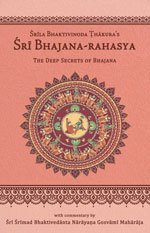Bhajana-Rahasya
by Srila Bhaktivinoda Thakura Mahasaya | 2010 | 123,965 words
The Bhajana-rahasya Text 9, English translation, including commentary (vritti). The Bhajana-rahasya is a compilation of verses describing the mercy of the eight pairs of names (Yugala-nama) of the Maha-mantra. This is text 9 belonging to the chapter “Dvitiya-yama-sadhana (Pratah-kaliya-bhajana)” representing the first six dandas of the morning: approximately 6.00 a.m.–8.30 a.m.
Text 9
Asat-tṛṣṇā is of four kinds, as described in the Āmnāya-sūtra-vyākhyā:
ऐहिकेष्वैषणा पार-त्रिकेषु चैषणा’शुभा
भूति-वाञ्छा मुमुक्षा च ह्य् असत्-तृष्णाश् चतुर्-विधाःaihikeṣvaiṣaṇā pāra-trikeṣu caiṣaṇā’śubhā
bhūti-vāñchā mumukṣā ca hy asat-tṛṣṇāś catur-vidhāḥThe four types of asat-tṛṣṇā are as follows: (1) desire for objects of this material world, (2) desire for heavenly pleasures, like those of Svarga, (3) desire for mystic powers, and (4) desire for liberation.
पार-त्रिक ऐहिक एषणा भूति-काम
मुक्ति-काम एइ चारि असत्-तृष्णा नामpāra-trika aihika eṣaṇā bhūti-kāma
mukti-kāma ei cāri asat-tṛṣṇā nāma
Commentary: Bhajana-rahasya-vṛtti:
The desire to obtain that which is unrelated to Śrī Kṛṣṇa is known as asat-tṛṣṇā. This desire is of four kinds: (1) Desire for worldly, material objects and the various endeavours to obtain them. Śrīmad-Bhāgavatam (11.3.18) states: “karmāṇy ārabhamāṇāṃ duḥkha-hatyai sukhāya ca–the conditioned living entity endeavours to obtain pleasure for the senses but receives only misery.” (2) Desire to obtain the pleasures of the heavenly planets and the worship of various demigods and goddesses. (3) Desire to obtain mystic powers in order to bewilder people with material wonders and thereby attain wealth, worship, prestige and so forth. Human beings are attracted to aṣṭāṅga-yoga and to mystic powers like aṇimā and laghimā. (4) Desire for liberation.
These four desires are all opposed to bhajana, and therefore devotees of Śrī Bhagavān never accept them.
